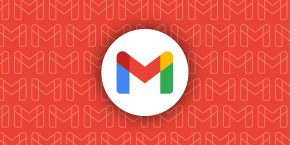
A big update to Gmail that brought Chat, Meet, and Rooms to one central hub was announced in July. That’s now rolling out to enterprise G Suite customers, while all personal accounts already have a dedicated Meet tab. Following those announcements, the company is readying a facelift for Gmail, and it starts with a new icon, if a teaser Google sent us is to be believed.
It’s clear based on the image Google sent us that the company is at least working on a new logo. This wouldn’t be surprising; in February, Google Maps greatly simplified its logo to a pin formed by the four company colors. Photos in June also dropped its realistic shape — a pinwheel — for very simple semi-circles. Most Google services have slowly been getting new icons to reflect this four-color brand.
As for the logo itself, this technical drawing likely shows how the new Gmail icon is put together. We clearly see an “M,” but the envelope icon (part of the current icon which dates back to 2013 — the shape has remained mostly the same since the service’s 2004 launch) is no longer explicitly there.
That shape is now only implied, with the whitespace above and below the center chevron/caret working to achieve that. It takes advantage of the blank background that is modern Android and iOS home screen icons. Meanwhile, it’s flat and the outer corners are much more rounded than before, fitting with Google’s latest design language.

Speaking of modern looks, this is an uncolored drawing. But if we were to look at other first-party icons, Gmail in all likelihood will incorporate blue, green, yellow, and red. The service has long been synonymous with that last color, but accents have greatly declined across Google products. Red in the app today is primarily consigned to the compose FAB and bottom bar.
Historically, for Google, new logos are accompanied by broader service redesigns. So it’s not a stretch to imagine that Gmail will be getting the same treatment to some degree in the coming months.

What’s next for Gmail
Google in June announced that Meet — hot off going free for all users — would be coming to Gmail for Android and iOS as a dedicated section. At the Cloud Next developer conference a month later, the company introduced tabs for Chat and Rooms, as well as the ability to collaborate on Docs in Gmail.
All those new features, along with Tasks integration, were additive and saw Gmail grow to become more than a traditional mail client. Yet, despite multiple opportunities over the years, Google has not meaningfully changed the core mailing experience.
Gmail’s history has been one of incrementalism and straightforward UI modernizations. The last major redesign in 2018 for the web and 2019 on Android/iOS primarily introduced the Google Material Theme. When Google wanted to try something else with email it created an entirely separate skin — of sorts — with Inbox in 2014.

Inbox by Gmail had some big ideas about how to organize incoming messages. It was much more than a reverse-chronological list as “Bundles” worked to group emails related to Travel and Purchases. Meanwhile, you could only ever archive to have it disappear from the inbox.
By the 2019 deprecation, what Google added to Gmail from the experimental service did not fundamentally alter the way we do email. Rather, you could snooze (hide) messages until a later time, quickly archive or delete by hovering when in the main inbox view, and send contextual smart replies. All of these are conveniences that just improve the experience of managing email.
In all likelihood, that historically iterative approach will continue with the updates that launch alongside this logo. When all the new features were added to Gmail in July, G Suite head Javier Soltero noted:
“People tell us they feel overloaded with too much information and too many tasks across too many different tools. Instead of learning another tool, we need the tools we already use to be even more helpful, and work together, in an integrated, intuitive way.”
The key observation made by Google is that people don’t want to “[learn] another tool.” People know what email is and live with it. With over 1.5 billion users (as of 2018), Google would not want to radically change that.
FTC: We use income earning auto affiliate links. More.

Comments